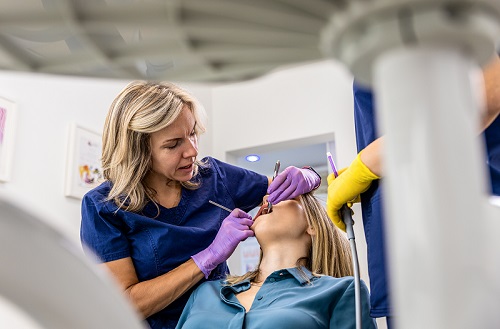Last Updated on: 27th February 2024, 11:41 pm
Table of Contents
Can Cavities Cause Headaches?
To understand the headache associated with teeth, it is necessary to know a little more about cavities.
Tooth decay is initiated by the presence of acids generated by bacteria called bacterial plaques present on the tooth surface, We must remember that the tooth is made up of mineralized tissues called the enamel that covers the crown of the tooth and then continues with the next layer called dentin and ending with the root cement located by the root of the tooth. The internal part is the non-mineralized tissues such as the pulp and periodontal ligaments. The pulp plays a very important role in the life of the tooth, which is why it is called the heart of the tooth.
The mineralized tissues fulfill the function of protecting the pulp from external chemicals and physical or biological agents. The pulp fulfills the function of cellular and nutritional support that dentin requires to form and prepare for when it is affected by any of the agents mentioned; the healthy pulp does not present inflammatory changes.

Like any other connective tissue, it requires a nerve supply to provide its two major functions, vaso-motor control, and defense. The components of the pulp tissue consist of motor and sensory nerve fibers, the latter coming from the fifth cranial nerve like the branches of a tree and made up of three major branches: ophthalmic, maxillary, and mandibular.
These nerve fibers will cause a painful sensation because of their high neural density. The pulp tissue is characterized by having a double sensory and autonomic innervation; the innervation is in charge of nerve fibers, both myelinated and unmyelinated that reach the pulp along with the vessels through the apical foramen.
Caries initially appears as white spots in the tooth enamel that result from superficial decalcification due to the attack of acids caused by bacteria. At this stage, it does not present symptoms such as pain, and acid continues to attack the caries progressing until it reaches the dentin. In this phase, the discomfort can be significant and pain appears. The pulp when feeling attacked tries to defend itself with the fibrous connective tissue generating an inflammatory reaction, then the pressure triggers a reflex and a crisis with manifestations of brain pain such as migraine or trigeminal neuralgia.
Other signs of advanced tooth decay
While a small cavity on a tooth’s surface is the typical first sign of tooth decay, there are other symptoms that could point to more severe decay. You should be aware of the additional indicators of advanced tooth decay listed below:

- Tooth Sensitivity: A sign that tooth decay has progressed is tooth sensitivity to hot or cold temperatures. This may be temporary or persistent and can indicate that the decay has reached the inner layer of the tooth.
- Tooache: Another sign of advanced tooth decay is a toothache, which may be dull or sharp and is caused by the decay reaching the nerve inside the tooth.
- Bad Breath: Due to the accumulation of bacteria that create volatile sulfur compounds in the mouth, tooth decay can also result in bad breath or a terrible taste in the mouth.
- Visible Holes or Pits: Advanced tooth decay may result in observable holes or pits on the tooth’s surface, along with discolouration or black patches.
- Swelling or Pus: In extreme circumstances, tooth decay that has proceeded can result in an abscess or infection that results in swelling, pus, or a fever. In such instances, prompt dental care is necessary.
How do you get rid of cavities?
Cavities are a widespread dental issue that affects millions of people worldwide. They occur when oral bacteria produce acids that gradually dissolve the tooth’s outer layer, causing a hole or cavity. If left untreated, cavities can cause tooth pain, infection, and even tooth loss. This article will delve into the process of cavity treatment and ways to prevent them.
Cavity treatment involves removing the decayed part of the tooth and filling it with a dental filling material. The procedure typically includes the following steps:

- Numbing the area: The dentist will use a local anesthetic to numb the area around the affected tooth to ensure the patient feels no pain during the procedure.
- Removing the decay: The dentist will use a drill or laser to remove the decayed portion of the tooth. They will then clean the area to eliminate any debris or bacteria.
- Filling the cavity: The dentist will fill the cavity with a dental filling material. There are several types of fillings, such as amalgam, composite resin, and porcelain. The type of filling used depends on the location and size of the cavity and the patient’s preference.
- Polishing: Once the filling is in place, the dentist will polish the tooth to make it smooth and comfortable.
Prevention is always better than cure. Here are some tips to prevent cavities:

- Brush twice a day: Brush your teeth twice a day for at least two minutes each time. Use fluoride toothpaste and brush all surfaces of your teeth, including the back of your mouth.
- Floss daily: Floss your teeth at least once a day to remove food particles and bacteria that can cause cavities.
- Limit sugary foods and drinks: Sugary foods and drinks contribute to tooth decay. Try to limit your intake of sugary foods and drinks, especially between meals.
- Regular dental checkups: Visit your dentist regularly for checkups and cleanings. This helps detect cavities early and prevents them from getting worse.
- Fluoride treatments: Fluoride treatments can help prevent cavities by strengthening the enamel of your teeth. Ask your dentist if fluoride treatments are right for you.
The pain or reflex can be located in any of the three branches of the fifth cranial nerve. Thus confirming that caries can generate many headaches if they are not identified in time. For this reason, we must visit the dentist at least twice a year to clean and dispose of dental caries.
At Channel Islands Family Dental Office we can help you get rid of the cavities that are causing you headaches. We have Dentist in Oxnard, Newbury Park, Port Hueneme Dentist, and Santa Paula ready to help you out. We accept all PPO insurance. We also accept Medi-Cal and Tricare insurance. Make an appointment today.



